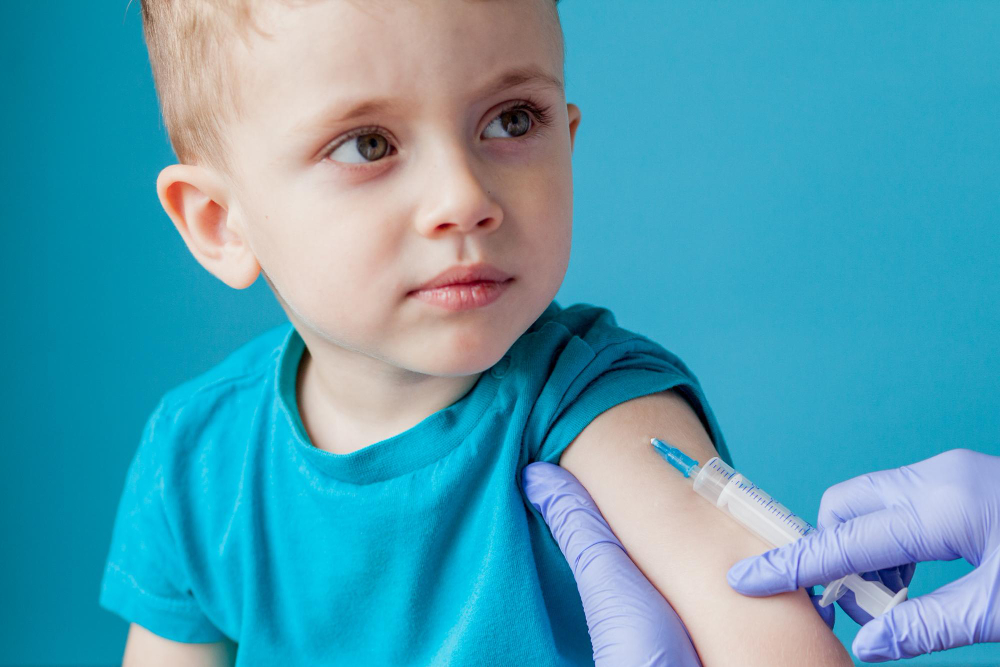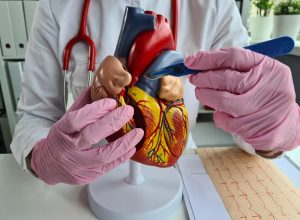Our Treatments

Vaccination
Vaccination stands as a cornerstone of public health, protecting individuals and communities from a range of infectious diseases. By stimulating the immune system to produce antibodies, vaccines prevent illnesses like measles, influenza, and COVID-19. Beyond individual protection, widespread vaccination campaigns contribute to global health by eradicating or controlling deadly diseases. Embracing vaccination not only saves lives but also reduces healthcare burdens, ensuring a healthier and more resilient future for all.

Asthma
Asthma is a chronic respiratory condition characterized by inflammation and narrowing of the airways, leading to recurring episodes of wheezing, coughing, chest tightness, and shortness of breath. Triggers such as allergens, respiratory infections, exercise, or irritants can exacerbate symptoms. Management involves medications like bronchodilators and corticosteroids to control inflammation and relieve symptoms, along with avoiding triggers and maintaining a healthy lifestyle. Regular monitoring and action plans help individuals manage their asthma effectively.

Allergies
Allergies occur when the immune system reacts excessively to harmless substances like pollen, pet dander, or certain foods. Symptoms vary from mild sneezing and itching to severe reactions like anaphylaxis. Allergy testing helps identify triggers, enabling avoidance measures and treatment with antihistamines, corticosteroids, or allergen immunotherapy. Managing allergies involves minimizing exposure to allergens and having emergency action plans for severe reactions.

Pneumonia
Pneumonia is a serious respiratory infection that inflames the air sacs in one or both lungs, leading to symptoms like coughing, fever, and difficulty breathing. It can be caused by bacteria, viruses, or fungi and is particularly dangerous for young children, the elderly, and those with weakened immune systems. Prompt medical attention and appropriate treatment, including antibiotics and supportive care, are crucial in managing pneumonia and preventing severe complications or fatalities.

Gastrointestinal Disorders
Gastrointestinal disorders affect the digestive tract, causing symptoms like abdominal pain, bloating, diarrhea, or constipation. Conditions range from acid reflux and gastritis to inflammatory bowel disease and celiac disease. Diagnosis involves medical history, physical examination, and sometimes imaging or endoscopic procedures. Treatment varies depending on the specific disorder and may include medication, dietary modifications, or surgery. Management aims to alleviate symptoms and improve gastrointestinal health.

Respiratory Infections
Respiratory infections affect the lungs and airways, causing symptoms like coughing, fever, and difficulty breathing. Common types include influenza, pneumonia, and bronchitis, often spread through airborne droplets or contact with infected surfaces. Treatment may involve rest, hydration, and medication to relieve symptoms. Vaccines and good hygiene practices like handwashing help prevent respiratory infections. Early detection and treatment are crucial for recovery.

Cerebral Palsy
Cerebral Palsy (CP) is a group of lifelong movement disorders resulting from damage to the developing brain. It affects muscle coordination and control, often leading to difficulties with movement, posture, and balance. Causes include prenatal, perinatal, or postnatal factors such as infections, oxygen deprivation, or brain injuries. Treatment involves multidisciplinary approaches like physical therapy, occupational therapy, medications, and surgeries tailored to individual needs to improve mobility and quality of life.

Pediatric Diabetes
Pediatric diabetes refers to diabetes in children, primarily Type 1 diabetes, where the body doesn’t produce enough insulin. Symptoms include increased thirst, frequent urination, and weight loss. Management involves insulin therapy, blood sugar monitoring, and a balanced diet. Families receive education on insulin administration and lifestyle adjustments. Regular medical check-ups and support from healthcare providers are essential for optimal diabetes management in children.

Ear Infections
Ear infections occur when bacteria or viruses infect the middle ear, causing pain, inflammation, and sometimes fluid buildup. Common in children, symptoms include ear pain, fever, and difficulty hearing. Treatment may involve antibiotics for bacterial infections, pain relievers, and ear drops. In severe cases or recurrent infections, surgical procedures like tympanostomy tube insertion may be necessary. Prompt medical attention helps alleviate symptoms and prevent complications.

Pediatric Cancers
Pediatric cancers are malignancies that affect children and adolescents, although relatively rare compared to adult cancers. Types include leukemia, brain tumors, and lymphomas. Symptoms vary depending on the type and location of the cancer but may include unexplained weight loss, persistent pain, and unusual lumps or swelling. Treatment typically involves chemotherapy, radiation therapy, surgery, or a combination, tailored to the specific cancer and individual patient needs. Early diagnosis and comprehensive care improve outcomes.

Down Syndrome
Down syndrome, a genetic disorder, results from the presence of an extra copy of chromosome 21. It leads to physical and cognitive developmental delays, distinctive facial features, and potential health issues like heart defects and thyroid disorders. Early intervention programs, medical care, and educational support help individuals with Down syndrome reach their full potential. Supportive environments and inclusion promote their well-being and quality of life.

Congenital Heart Defects
Congenital heart defects (CHDs) are structural abnormalities present at birth, affecting the heart’s structure and function. They vary in severity, from minor defects to life-threatening conditions. Causes may be genetic or environmental factors. Symptoms include blue-tinted skin, rapid breathing, and poor feeding. Treatment options range from medication and monitoring to surgical intervention. Early detection through prenatal screening and comprehensive care improve outcomes for individuals with CHDs.

Pediatric Dermatological Conditions
Pediatric dermatological conditions encompass various skin disorders affecting children, from birthmarks and eczema to infections like impetigo and fungal rashes. Treatment depends on the specific condition and may involve topical medications, oral antibiotics, or antifungal creams. Management also includes proper skincare, avoiding triggers, and lifestyle modifications. Regular monitoring by dermatologists ensures effective management and improves the quality of life for children with dermatological conditions.

Pediatric Infectious Disease
Pediatric infectious diseases are illnesses caused by pathogens such as bacteria, viruses, fungi, or parasites, affecting children’s health. Common examples include respiratory infections like flu, gastrointestinal infections, and childhood vaccinations prevent many of these diseases, while treatment often involves antibiotics, antiviral medications, or supportive care. Prevention strategies include good hygiene practices, vaccination, and minimizing exposure to infectious agents. Early diagnosis and treatment are crucial for optimal outcomes.

Developmental Delays
Developmental delays refer to when children do not reach developmental milestones at expected times. Causes can vary from genetic conditions to environmental factors. Delays can affect areas like motor skills, language, or socialization. Early intervention programs provide therapies such as physical, occupational, or speech therapy to support children’s development. Regular assessments help identify delays, allowing for timely interventions to help children reach their full potential.

Childhood Obesity
Childhood obesity, a growing concern worldwide, results from an imbalance between calorie intake and energy expenditure. Contributing factors include unhealthy diets, sedentary lifestyles, genetic predisposition, and environmental influences. Health risks associated with childhood obesity include diabetes, cardiovascular disease, and psychological issues. Prevention strategies include promoting healthy eating habits, regular physical activity, and supportive environments at home and school. Early intervention is crucial for long-term health outcomes.

Attention Deficit Hyperactivity Disorder
Attention Deficit Hyperactivity Disorder (ADHD) is a neurodevelopmental disorder characterized by inattention, hyperactivity, and impulsivity. It affects children and adults, impacting academic, social, and occupational functioning. Diagnosis involves clinical assessment based on specific criteria. Treatment typically involves behavioral therapy, medication, or a combination, tailored to individual needs. Supportive interventions at home, school, and work help manage symptoms and improve quality of life for those with ADHD.

Pediatric Neurological Disorders
Pediatric neurological disorders affect the brain, spinal cord, and nervous system in children. Conditions range from epilepsy and cerebral palsy to developmental delays and autism spectrum disorder. Diagnosis involves neurological examination, imaging studies, and sometimes genetic testing. Treatment varies depending on the disorder and may include medication, therapy, or surgery. Early intervention and ongoing support help manage symptoms and improve outcomes for children with neurological disorders.

Feeding Problems
Feeding problems in children encompass a range of difficulties related to eating, swallowing, or nutrition intake. Causes can include developmental delays, sensory issues, or underlying medical conditions. Symptoms may include refusal to eat, choking, or poor weight gain. Treatment involves a multidisciplinary approach including feeding therapy, dietary modifications, and addressing any underlying medical issues. Early identification and intervention are crucial for addressing feeding problems and ensuring proper nutrition.

Epilepsy, Convulsions
Epilepsy is a neurological disorder characterized by recurrent seizures due to abnormal brain activity. Seizures can manifest as convulsions, involuntary movements, altered consciousness, or sensory disturbances. Treatment involves antiepileptic medications to control seizures, along with lifestyle modifications. In severe cases, surgery or other interventions may be necessary. Management aims to reduce seizure frequency and severity, improve quality of life, and minimize potential complications.

Infantile Colic Pain
Infantile colic pain refers to excessive crying and fussiness in otherwise healthy infants, typically occurring in the first few months of life. The exact cause is unclear, but factors like gastrointestinal discomfort, immature digestive systems, or excessive gas may contribute. Management strategies include comforting techniques, dietary modifications, and soothing measures. Although colic is distressing, it generally resolves on its own by the age of three to four months.

Juvenile Idiopathic Arthritis
Juvenile Idiopathic Arthritis (JIA) is a chronic autoimmune condition causing joint inflammation in children under 16. Symptoms include joint pain, swelling, and stiffness, which may affect mobility and quality of life. Treatment involves medications to reduce inflammation and manage symptoms, along with physical therapy to improve joint function. Regular monitoring by healthcare professionals is essential to prevent complications and ensure optimal management of JIA.

Autism Spectrum Disorder
Autism Spectrum Disorder (ASD) is a developmental condition affecting social communication and behavior. It includes a wide range of symptoms and severity levels, from mild to severe. Early signs may include delayed speech, repetitive behaviors, and difficulty with social interaction. Diagnosis involves comprehensive evaluation by healthcare professionals. Treatment focuses on behavioral therapies, educational support, and sometimes medication to manage symptoms and improve functioning.

Short Height
Short height in children can result from various factors including genetics, underlying medical conditions, or poor nutrition. Evaluation by healthcare professionals involves assessing growth patterns, family history, and potential underlying causes. Treatment may include addressing any medical conditions, nutritional supplementation, hormone therapy, or growth hormone injections in some cases. Early detection and intervention are crucial for optimizing growth and addressing any underlying issues.

